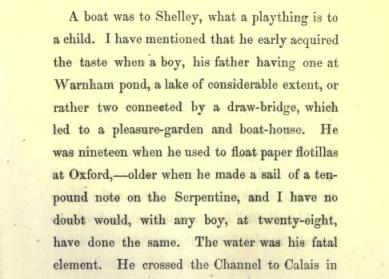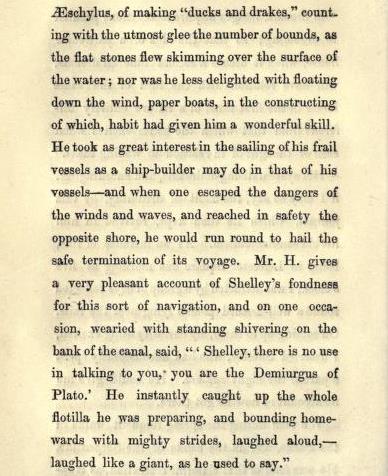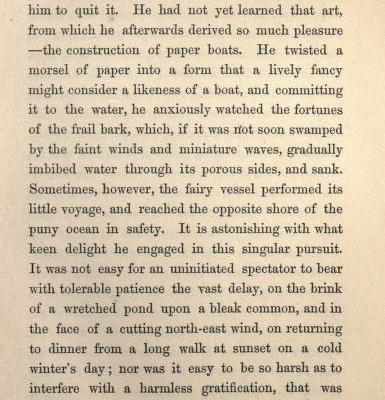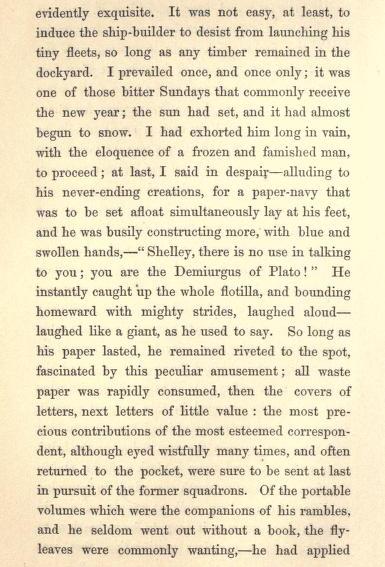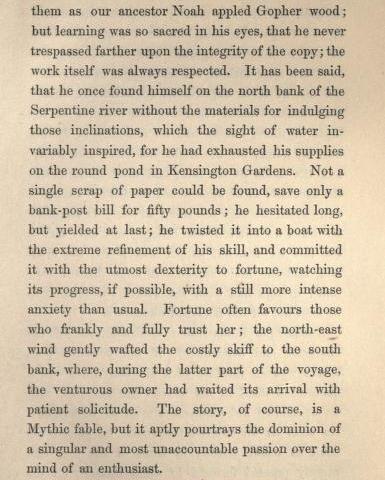| The Public Paperfolding History Project
x |
|||||||
| Percy Bysshe Shelley and his love of paper boats | |||||||
| This
page attempts to record what is known about the passion
of the English Romantic poet, Percy Bysshe Shelley, for
folding and sailing paper boats. Please contact me if you
know any of this information is incorrect or if you have
any other information that should be added. Thank you. In his article On The Origin Of Paper Money Folding, David Lister says: 'Ways of folding simple paper-folded boats by what we know as origami techniques were known, even in those days but apparently Shelley just scrunched up the paper into some sort of hollow and we cannot be sure that he used folding techniques.' I cannot find the source of David Lister's information on this point. ********* In July 1820 Shelley wrote a poem 'Letter to Lady Gisborne' which includes the lines: 'And in this bowl of quicksilver - for I / Yield to the impulse of an infancy / Outlasting manhood - I have made to float / A rude idealism of a paper boat:' ********** There are several mentions of Shelley's passion for making and sailing paper boats in works by Thomas Medwin. From 'Memoir of Percy Bysshe Shelley' published in London by Whittaker, Treacher and Co in 1833:
From 'The Life of Percy Bysshe Shelley', published, in two volumes, in London by Thomas Cautley Newby in 1847:
***
********** In Volume 1 of his own 'The Life of Percy Bysshe Shelley', published in 1858, his friend Thomas Jefferson Hogg, devoted several pages to describing Shelley's passion for folding and sailing paper boats.
********** 'The Popular Recreator', which was published by Cassell and Co in London in 1873, contains diagrams for the Paper Boat and also mentions Percy Bysshe Shelley's fascination with 'making and floating them'. It is clear that the author of this article, who is not named in the book and whose identity is unknown, believed that the boats habitually made by Shelley were of the traditional Paper Boat design.
********** J M Barrie's novel 'The Little White Bird', was first published in Scribner's Magazine in America as a monthly serial from August to November November 1902, then as a complete novel by both Hodder & Stoughton in London and Scribner's in November of the same year. Chapter 15, titled 'The Thrush's Nest' includes mention of a paper boat made from a £5 note by a character called Shelley. In the story Shelley's boat is simply a device to put both a five pound note and an idea into Peter Pan's mind. Full details can be found here. ********** Mention of Shelley's passion for paper boats can also be found in 'Ariel ou la Vie de Shelley' by Andre Maurois, which was published in Paris in 1923. This passion is mentioned in two separate passages: The first reads 'Les deux jeunes gens devinrent inséparables. Chaque matin, ils se promenaient à pied: Shelley se conduisait en route comme un enfant, courant sur les talus, sautant les fossés. Quand il rencontrait un étang ou une rivière, il lançait des bateaux de papier et les suivait jusqu'au naufrage, tandis que Hogg exaspéré attendait debout sur la rive' which translates to English as 'The two young people became inseparable. Each morning, they walked on foot: Shelley behaved on the way like a child, running on the slopes, jumping the ditches. When he encountered a pond or river, he launched paper boats and followed them until they sank, while Hogg waited, exasperated, standing on the shore.' In the English version of this book, 'Ariel The Life of Shelley' translated by Ella D'Arcy, published in 1924, the start of the second sentence of this passage appears as 'When he came to any water he launched paper boats, and sent little Argosies trembling down the Isis', the second half clearly being a romantic interpolation of the translator. The second reads: 'Quand, au bord de la Serpentine, il s'amusait, comme jadis à Oxford, à lancer des barques de papier, Mary, assise à côté de lui, construisait la flotte avec ardeur' which translates to English as 'When, at the edge of the Serpentine, he amused himself, as before at Oxford, by launching paper boats, Mary, seated next to him, built the fleet with enthusiasm.' Ella D'Arcy paraphrases this as 'When he amused himself at the Serpentine, just as he used to do at Oxford, in launching a paper flotilla, Mary, sitting beside him, fashioned the boats with tireless fingers.' ********** |
|||||||

